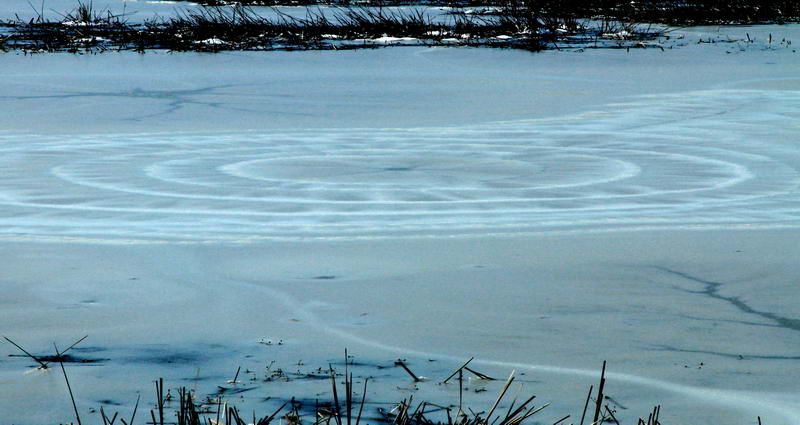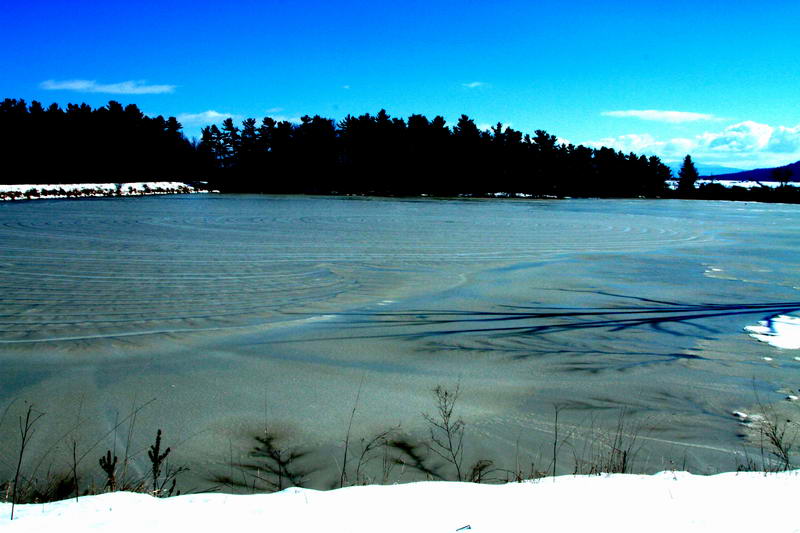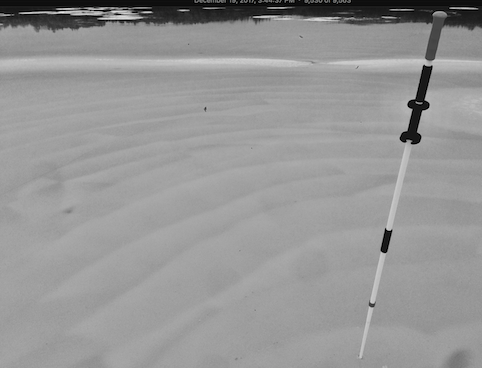Very Large Ice Rings
 Ice rings on Dead Creek. Note
Ice rings on Dead Creek. Note
Summary
I found a large, unusual and eye catching feature on Dead Creek in Addison Vermont in mid-March 2013. It looked like the ice was covered with huge bull's eyes: large concentric circles around a central upflow hole (ice star). They appear to be an up-flow feature similar to ice octupi (ice stars) but they are much bigger. The biggest was around 400 feet in diameter. The following explanation for what might be going on.

The main circular part of this ring system is about 400 feet across. The dark shadow coming in to the picture from the lower right is a tree shadow. Dark, branched inflow channels can be seen coming in from the lower edge and the right side.
In early 2017 many examples of giant ice rings were found on Lake Champlain and surrounding ponds.
Note: Most of the pictures of ice rings have had the contrast pushed as camera sensors are less effective at showing contrast than the human eye is at seeing it.
This is a part of a larger story.
Details
Dead Creek is an impounded creek with large amounts of wetlands surrounded by wildlife refuges and farms.
The temperatures leading up to March 21, 2013 when I first saw the rings.
This weahter data and graph is from https://www.wunderground.com
It looks like it was warm enough from the 9th to the 14th to remove winter ice. In the colder weather up to the 18th it looks like it refroze (probably on the 16th). On the 18 th it got warm again and stayed near freezing though the 21st. It snowed a couple inches on the on the 19th.
In 2017 the weather was cold from when the snow fell to when we got on the ice to see them. Cold temperatures may not be an important ingredient. The critical parameter apears to be an ice sheet that is thin or thawed enough to be weak enough to break when snow on the surface of the ice is covered with enough snow to break the black ice layer under the snow then that snow gets saturated with water. The rings probably form one at a time starting from an ice star at the center. The rings appear to be a result of water flowing up through the most recently formed ring crack and radially outward until the weight of the slush breaks the black ice layer. By then there enough weight has built up to crack the ice at the edge of the newly saturated ring. The new crack allows the water to flow up and repeat the process. Based on the speed that water penetrates fluffy snow (roughly an inch per second) the individual rings might form as quickly as a minute or less.
The rings found on Shelburne Pond on December 19, 2017 covered a percent or two of the area of the pond (rough guess). Areas that had rings had few, if any, ice stars. Where there were no ice rings the ice stars averaged a few feet apart. From looking at cross sections of the ice it looks like the initial ice sheet was about 1/4" thick(??). A thin black ice layer was probably necessary to allow the black ice to break regularly. The width of the 2017 rings appears to be narrower than the the 2013 rings. This may reflect a thicker but thawed (weaker) black ice layer.
The 2017 rings occurred near shore on Lake Champlain and some of the surrounding ponds. There was a 4", cold snow storm when the lake first came in. Given that there was an ice star (upflow hole) at the center of the ice rings it is likely that there was a thin layer of ice for the ice to break under the weight of an inch or so of of saturated snow slulsh. The ice rings in 2017 were much narrower with much shorter arms that the 2013 rings. Ice stars tend to be bigger in thicker ice, especially in warm conditions.
 2017 large ice rings - Shelburne Pond December 19, 2017. These rings are narrower than the rings seen at Dead Creek in 2013.
2017 large ice rings - Shelburne Pond December 19, 2017. These rings are narrower than the rings seen at Dead Creek in 2013.
This is a part of a larger story. See:Large Ice Rings 2
